Introduction
- Vaccination is one of the most effective ways to prevent diseases.
- For children, vaccination helps prevent epidemics of such diseases as measles, pertussis, mumps, rubella, and so on, as these diseases are highly contagious.
- Somalian parents in their community in Minnesota refuse from their children being vaccinated, as they believe that vaccination causes autism (Decoteau 170).
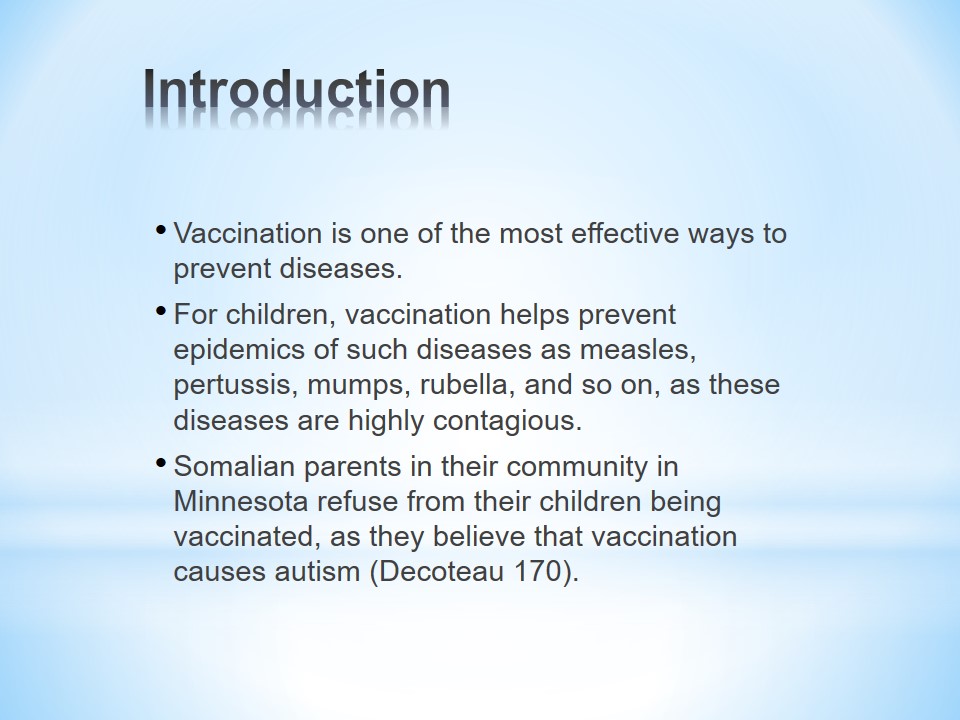
Goals of the Intervention
- To increase public awareness of the given problem.
- To engage all the stakeholders in order to facilitate the solution of the problem.
- To provide the proof that vaccination does not cause autism.
- To demonstrate the dangers that such diseases as measles or mumps can bring.
- To ensure that all children are vaccinated (“MAP-IT: A Guide to Using Healthy People 2020 in Your Community”).

Mobilize
- To address to the Minnesota Health Improvement Partnership, the members of which increase public awareness of this problem.
- To organize particular events and develop education programs aimed at demonstrating the evidence that refutes the belief that vaccination causes autism.
- To demonstrate what dangers the refusal from child vaccination can cause.
- To provide assistance in solving the problem (Hall et al. 713).
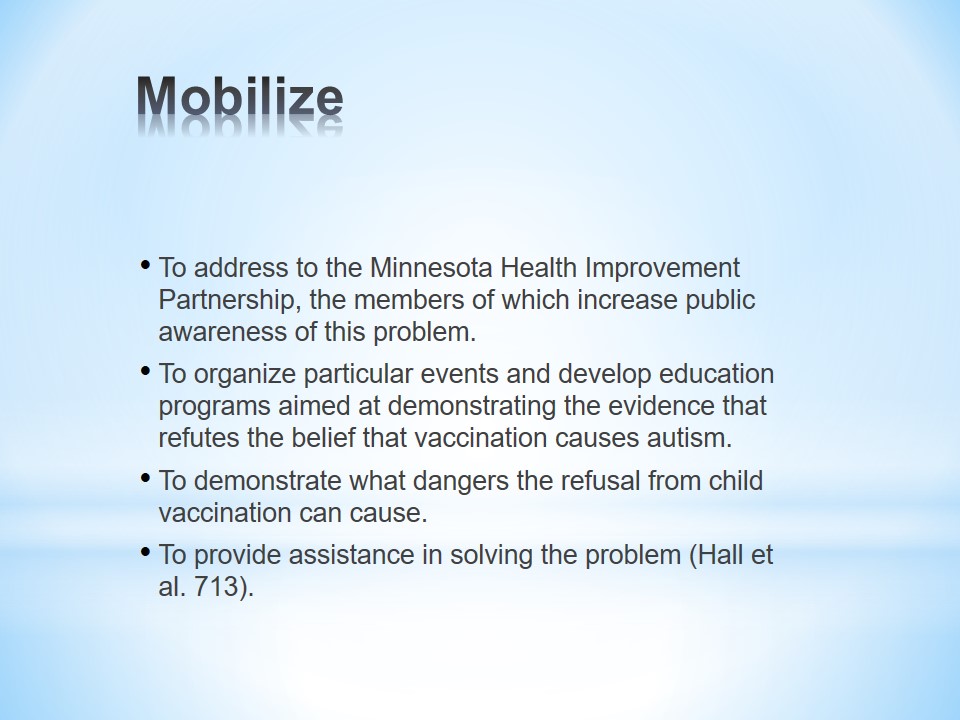
Assess
- According to the survey, 35% of Somalian parents are confident that vaccination causes autism.
- More than a half of Somalian parents refused their children to be provided with more than one vaccine at one visit.
- The refusal rates are increasing, as Somalians are more likely to believe their neighbors in the community than the qualified medical personnel (Pruitt et. al. 12).
- The given problem concerns not only Somalian children in their community but also other children that they contact with.
- The child diseases, such as mumps, measles, chickenpox, pertussis, rubella, scarlet fever, and others are considered as highly contagious (Hall et al. 713).
- Various public and private health organizations can provide additional financial resources on the creation of education programs for Somalians.
- The involvement and commitment to the problem on the side of the key stakeholders and community members is required (Wolff and Madlon-Kay 459).
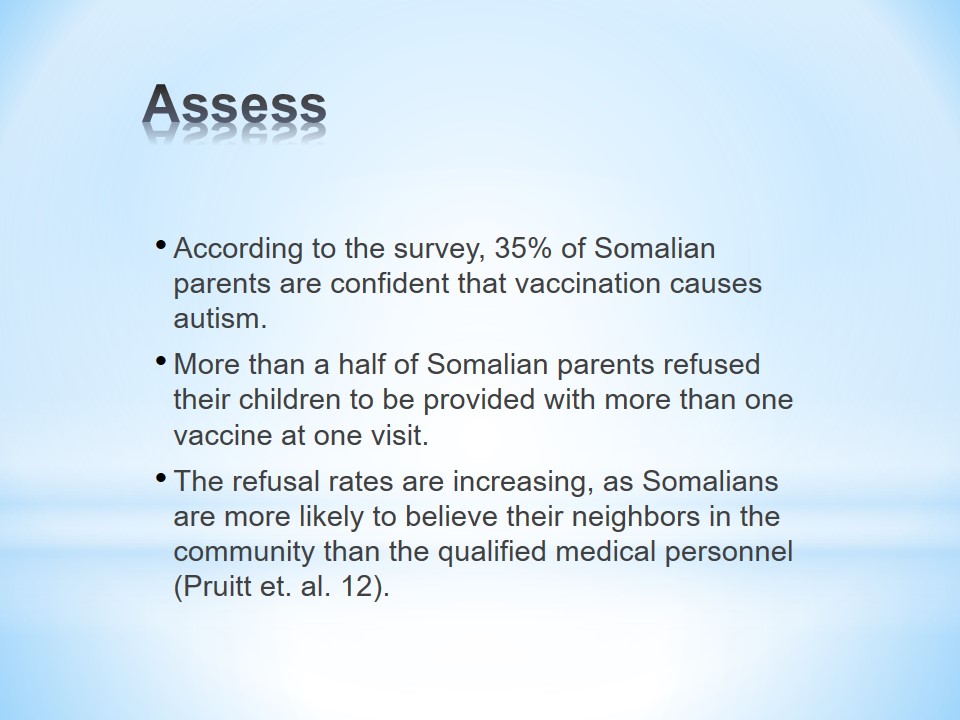
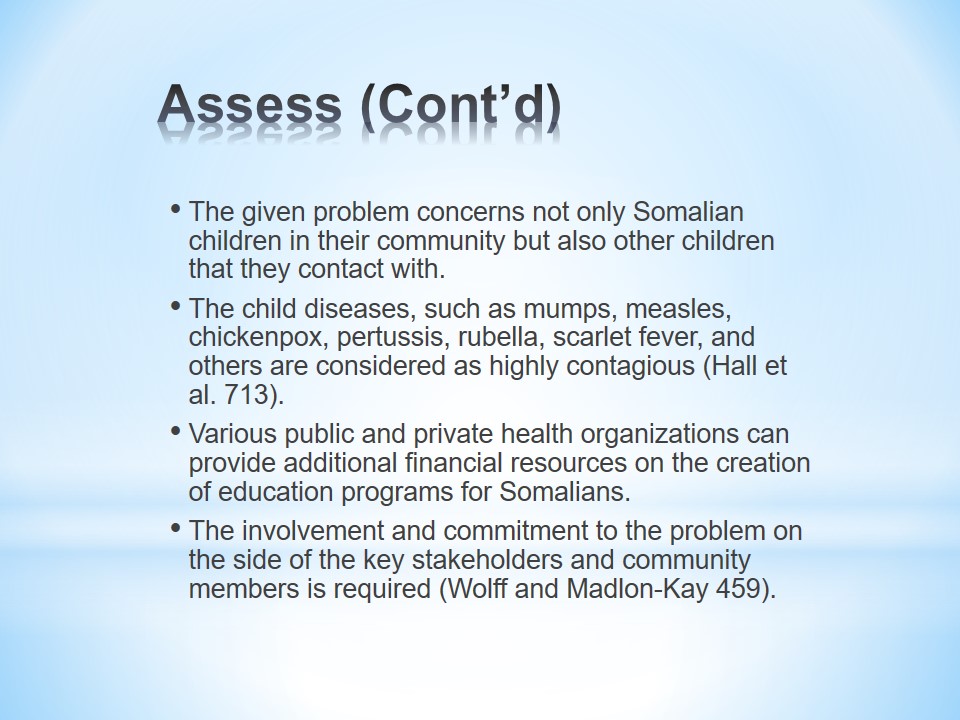
Plan (First Steps)
- Applying to Minnesota Health Improvement Partnership.
- Enlisting financial and human resources support from the Minnesota Department of Health, the Minnesota Medical Association, and the Somali American Parent Association.
- Hiring Somali staff and improving their competence and cultural knowledge (Haelle).

Plan (Educational Programs)
- The distribution of travel immunization information.
- The promotion of YouTube videos about autism and vaccination.
- The promotion of media campaigns concerning vaccination.
- The improvement of the Children & Youth with Special Health Needs program.
- The implementation of training and outreach programs.
- The development of education programs for Somalians (Haelle).

Plan (Further Intervention)
- One-on-one conversations between specialists in medicine and Somalian parents.
- Collecting the evidence that vaccination does not cause autism.
- Finding Somalian children with autism who have not been vaccinated (Haelle).
- Increasing the Somalian’s awareness of the threat to the health that the refusal from vaccination constitutes.
- The complete vaccination of children whose families initially refused (Decoteau 171).
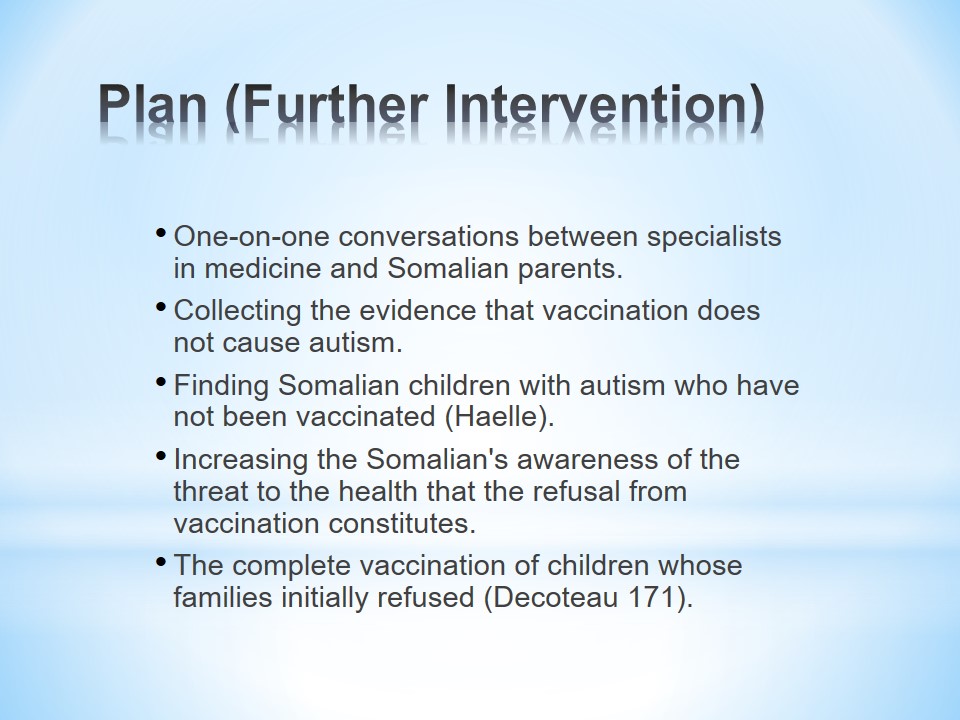
Implement
- Making sure that all the stakeholders are involved in the process of the intervention.
- Involving new partners with fresh ideas and energy into the process (“MAP-IT: A Guide to Using Healthy People 2020 in Your Community”).
- Interviewing Somalian parents in order to find out how the attitude towards vaccination is changing and whether it is changing at all.
- Organizing various activities and meetings to demonstrate the progress of the intervention (Wolff and Madlon-Kay 461).
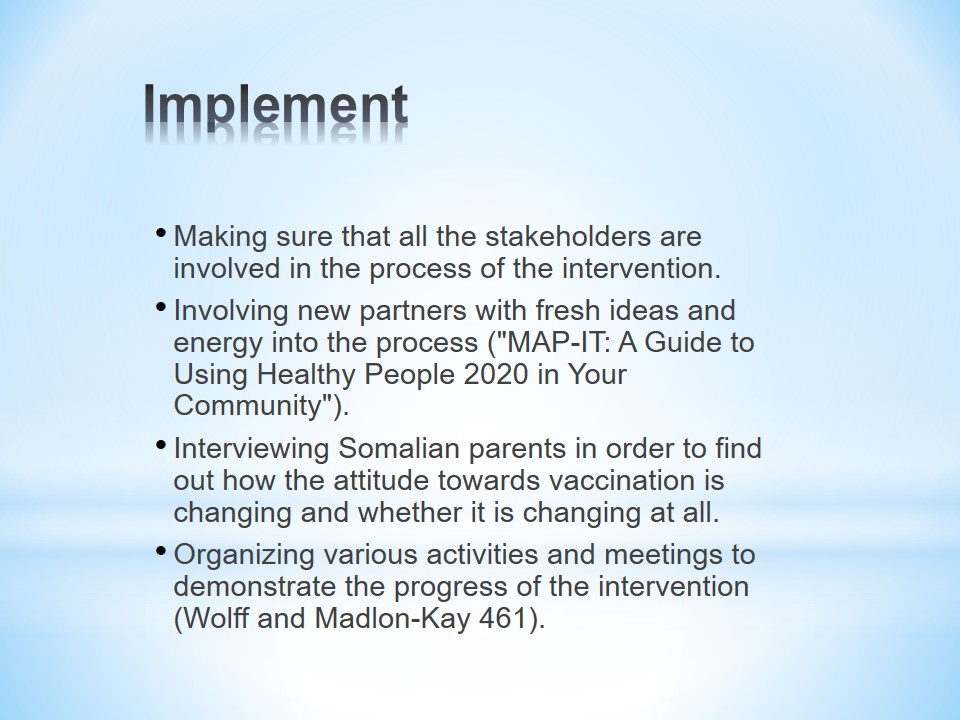
Track
- Making a final interview with Somalian parents regarding their opinion towards vaccination and autism.
- Applying to a local center of health statistics so that they could help data tracking (Haelle).
- Developing and conducting a survey to find out the overall results of the rates of vaccination among Somalian children.
- Checking the collected data on its validity.
- Publicly announcing the results of the intervention (“MAP-IT: A Guide to Using Healthy People 2020 in Your Community”).
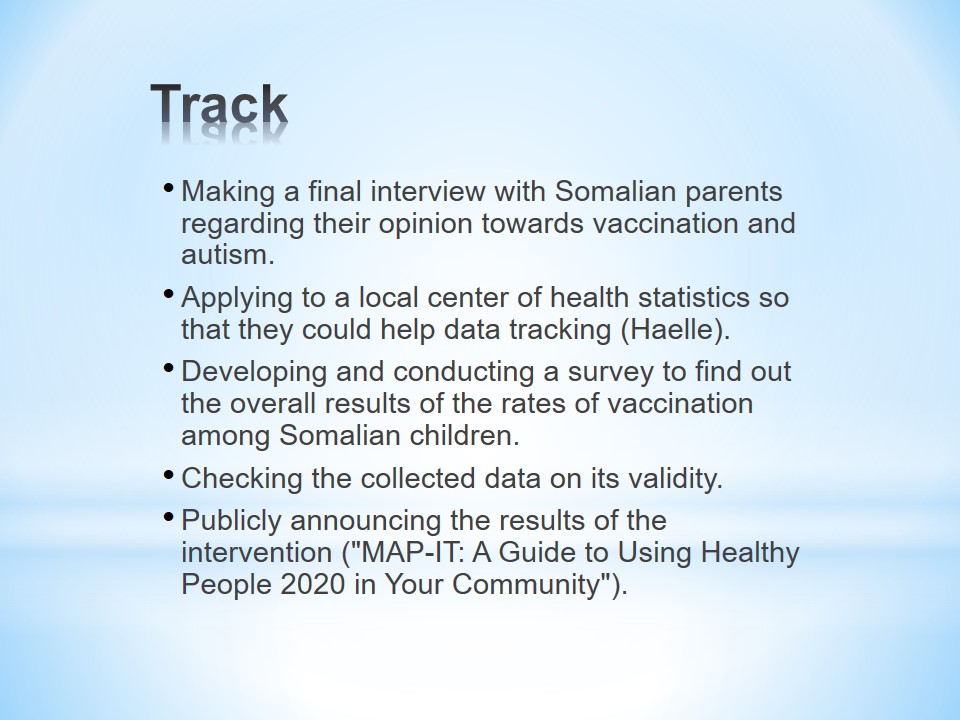
Potential Barriers and Limitations
- The lack of support on the side of the health organizations and key stakeholders.
- The solution is to address as many organizations as possible and increase public awareness of the problem (Pruitt et. al. 15).
- The Somalians are much more likely to believe their relatives, neighbors, or other people from their community rather than qualified medical specialists.
- The solution is to involve other Somalians who are confident that vaccination does not cause autism (Haelle).
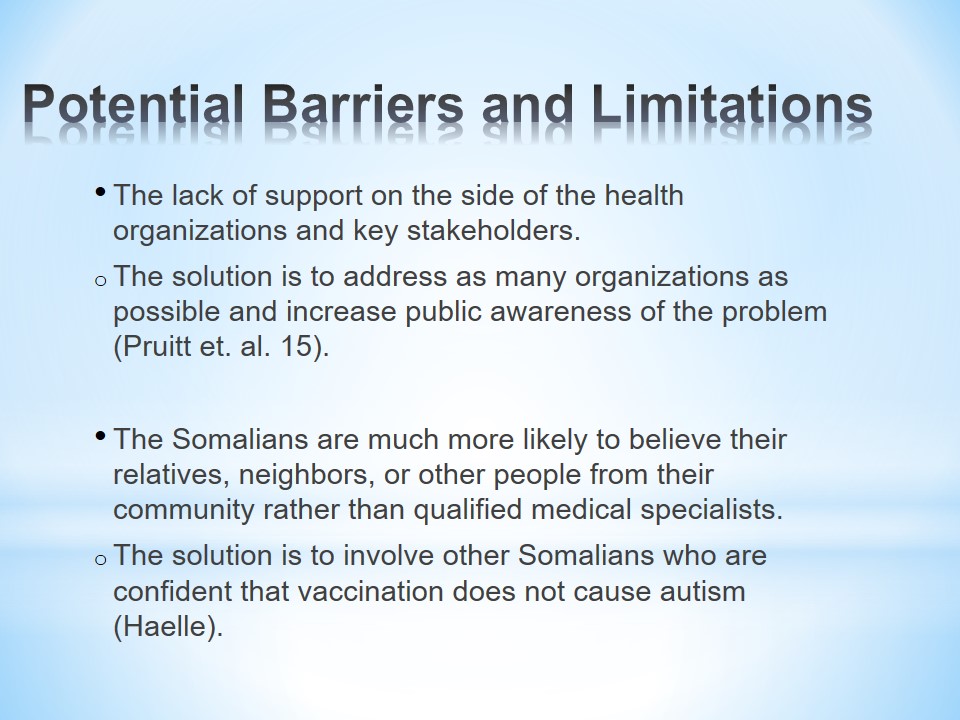
Conclusion
- The proposed intervention is effective in terms of helping Somalian parents understand that vaccination does not cause autism.
- The proposed educational programs for Somalian people can help them understand the real threat that the refusal from vaccination poses for their children.
- The provided obstacles that can linger the intervention are not significant and can be overcome.
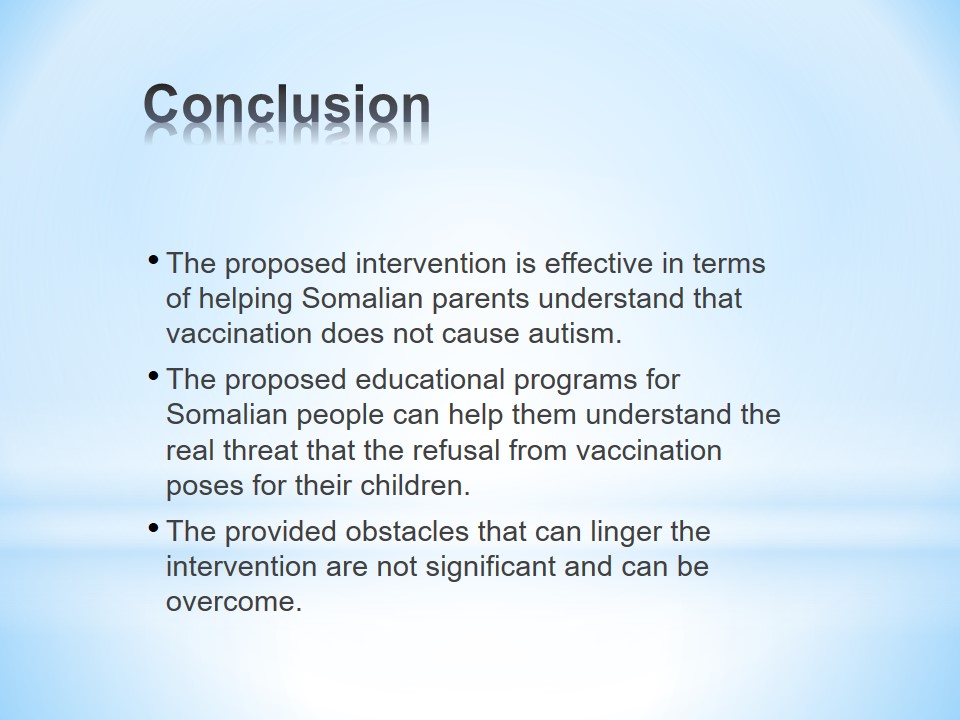
Works Cited
Decoteau, Claire Laurier. “The “Western Disease”: Autism and Somali Parents’ Embodied Health Movements.” Social Science & Medicine, vol. 177, no. 3, 2017, 169-176.
Haelle, Tara. “Cultural Approach to Vaccine Hesitancy Essential for Ethnic Communities.” MDedge. 2016. Web.
Hall, Victoria, et al. “Measles Outbreak – Minnesota April-May 2017.” Morbidity and Mortality Weekly Report, vol. 66, no. 27, pp. 713-717.
“MAP-IT: A Guide to Using Healthy People 2020 in Your Community.” Healthy People 2020, 2017. Web.
Pruitt, Ms Crystal N., et al. “Comparison of Medical Service Utilization and HPV Vaccination Rates among Somali and White/non-Hispanic Females.” Journal of Lower Genital Tract Disease, vol. 19, no. 1, 2015, 12-16.
Wolff, Emily R., and Diane J. Madlon-Kay. “Childhood Vaccine Beliefs Reported by Somali and Non-Somali Parents.” The Journal of the American Board of Family Medicine, vol. 27, no. 4, 2014, pp. 458-464.